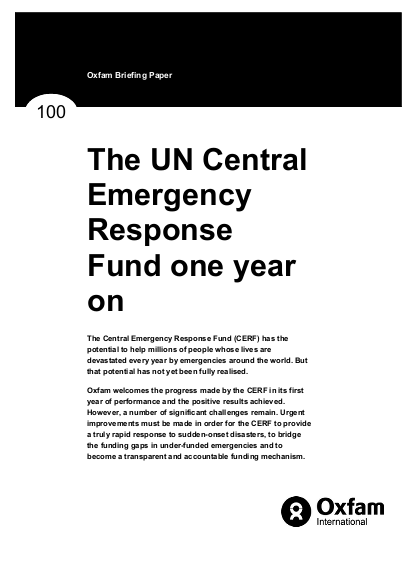Oxfam Briefing paper 100

Field data reveals that, in many locations, CERF funding has enabled accelerated implementation of life-saving programmes. Analysis also shows that several emergencies have received more aid in absolute terms than in previous years. In particular, under-funded or ‘forgotten’ emergencies have benefited from the availability of extra funding. However, in cases of extreme under-funding, CERF allocations have been too small to contribute significantly to a more equitable global response. Despite clear evidence of positive results in some areas, and signs of learning and continuing progress in the administration of the Fund, Oxfam’s research also shows that in 2006 the CERF experienced serious administrative and disbursement delays both at HQ level in New York and in the field. Most often it is NGOs who respond first and best to rapid-onset disasters, providing about 80 per cent of service delivery.
However, NGOs are excluded from directly accessing CERF funding. Instead, UN agencies forward a large percentage of CERF allocations to operational agencies in the field – often with significant delays and after charging a significant administrative fee (officially limited to 7 per cent). These shortcomings significantly reduced the CERF’s rapid response capacity and might well have negative medium-term consequences for the humanitarian response system as a whole. NGOs’ future humanitarian responses depend on improved access to CERF resources and the continued availability of other (bilateral) sources of funding. The research also reveals a dearth of record-keeping and evaluation, making it difficult in many cases to judge the CERF’s impact. Lastly, it has proved extremely difficult to confirm whether donor contributions to the CERF have consisted of ‘new’ or additional funding. The fear remains that CERF contributions could be funds diverted from other, bilateral humanitarian contributions and thus undermine two of the CERF’s key objectives: increasing the availability of aid, and improving results for people at risk through speedier humanitarian response.
